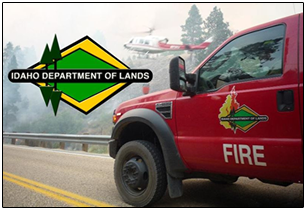More active fire season expected in North Idaho
 Most
of the 74 fires that State of Idaho firefighters
have put out so far this year have been caused
by people, not lightning. Fires resulting from
equipment, recreational shooting, and controlled
burns that escaped make up most of the
human-caused fires on lands protected by the
Idaho Department of Lands (IDL) and two timber
protective associations.
Most
of the 74 fires that State of Idaho firefighters
have put out so far this year have been caused
by people, not lightning. Fires resulting from
equipment, recreational shooting, and controlled
burns that escaped make up most of the
human-caused fires on lands protected by the
Idaho Department of Lands (IDL) and two timber
protective associations.As the Independence Day holiday approaches, Idahoans also are reminded that fireworks are prohibited on forest and range lands in Idaho during closed fire season (May 10 through October 20).
Fire prevention and safety tips are available on the new web site, http://idahofireinfo.blogspot.com/.
What kind of fire season is expected?
National fire weather forecasters told the Land Board last week they expect a near normal fire season in southern Idaho and an above normal fire season for northern Idaho, where the State of Idaho has much of the responsibility for fighting wildfire.
Low snowpack and low soil moisture contributed to conditions in May and June that fire managers do not usually see until July. Tree stumps are burning three to four feet into the ground and bushes that usually stay green and absorb the fire to slow it down are actually burning and contributing to the spread of fire. The low subsoil moisture probably is the result of a cold snap last November prior to snowfall that did not allow winter rain to penetrate the soil, so fires likely will burn deep into the soil and will be difficult to mop up without water.
This year, Idaho forests are drought-stressed and more prone to insect and disease damage. Fine fuels such as grasses are more prevalent than would be expected in a typical drought situation thanks to well-timed precipitation this year. A healthy snowpack usually will compact fine fuel vegetation from the previous season, but the limited snowpack this year left abundant standing fuels from last season to add to this growing season.
Factors that affect the severity of a fire season are global weather patterns, temperature, precipitation (amount and timing), snowpack, drought, and vegetation development.
Ten IDL forest protective districts and two timber protective associations together provide protection on more than 6.2 million acres of mostly State owned and privately owned timberlands in Idaho. Most of the lands we protect are located north of Grangeville. The other two fire agencies are the U.S. Forest Service (USFS) and Bureau of Land Management (BLM). Local fire districts and rangeland fire protection associations assist IDL, USFS, and BLM in our firefighting efforts.
The goal is to keep 94 percent of fires that burn on State-protected lands to 10 acres or less in size.
Prepared to fight fire
The ten IDL forest protective districts and two timber protective associations passed readiness reviews in early June. The IDL-conducted reviews ensure the State of Idaho is prepared to effectively fight fire and transition to an interagency management team if needed. As part of the review, IDL checks the condition of equipment and its proposed use, the training of personnel, and adequacy of liability insurance. For the associations, IDL also checks the governing and managing structure.
Equipment and personnel ready to go if needed
The State of Idaho's resource contributions to fighting wildland fire in Idaho include:
Contracted aircraft and on-the-ground resources:
• Four single engine air tankers, one based in Coeur d'Alene, two based in Grangeville, and one based in McCall
• One Type 2 helicopter based in Coeur d'Alene
• One Type 3 helicopter based in Grangeville
• One amphibious water scooper, or "Fire Boss" based in Coeur d'Alene that can scoop 800 gallons of water in 12-15 seconds and be off the water in as few as 20-30 seconds. It can carry an initial load of retardant and then work close to the fire, scooping from nearby lakes and rivers.
• 22 engines
• One dozer based in St. Maries
Trained personnel:
• Close to 200 permanent and seasonal fire personnel with the State of Idaho have logged thousands of hours of training in 2015 alone. A North Idaho Interagency Guard School, two interagency fire academies in southern Idaho, and the first-ever IDL Engine Academy since the spring provided basic wildland firefighting training to hundreds of firefighters employed by both State and federal agencies.
State of Idaho firefighters available for the 2015 fire season include:
• 31 three-person engine crews
• Two six-person hand crews
• Two helitac crews, one six-person and one seven-person
Fire management agencies share resources. The State personnel, aircraft and equipment can be dispatched for use on federally managed fires in-state or out of the state as needed, just as the State of Idaho can use federal resources to fight fire on lands protected by the State. Each agency reimburses another for use of its resources.
All that's left now is you--Please do your part and help prevent forest fires!